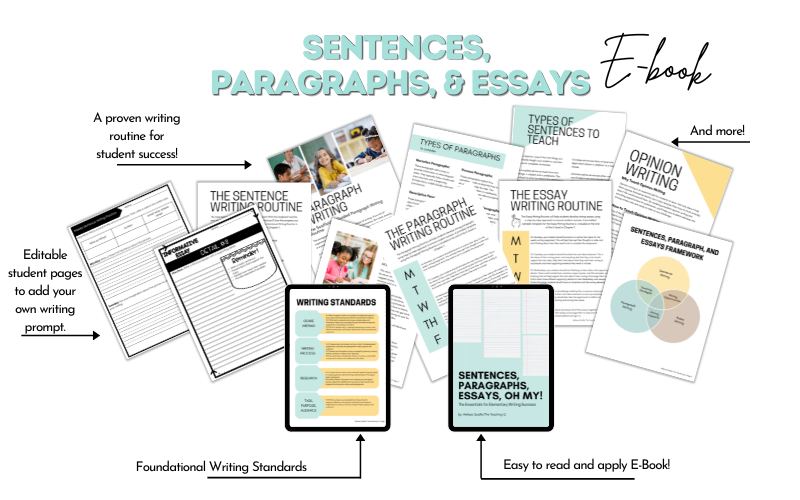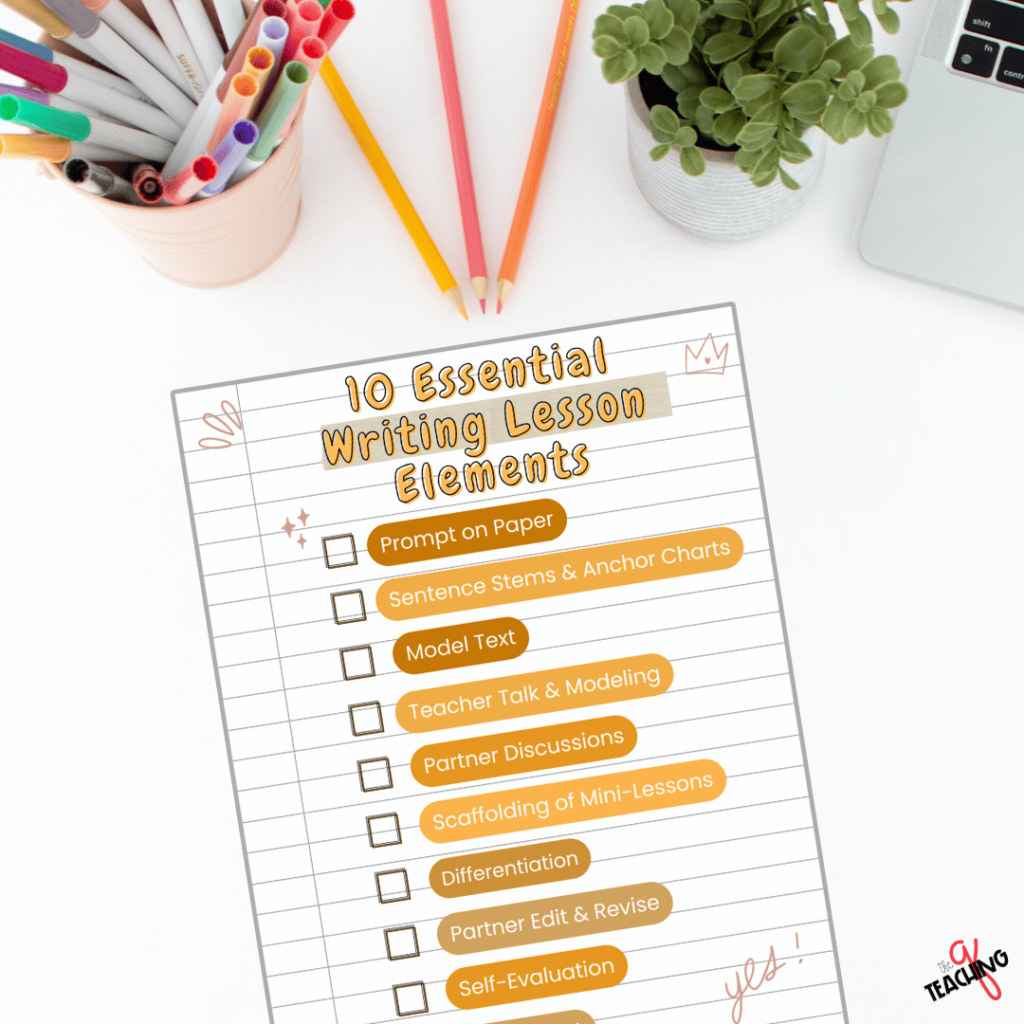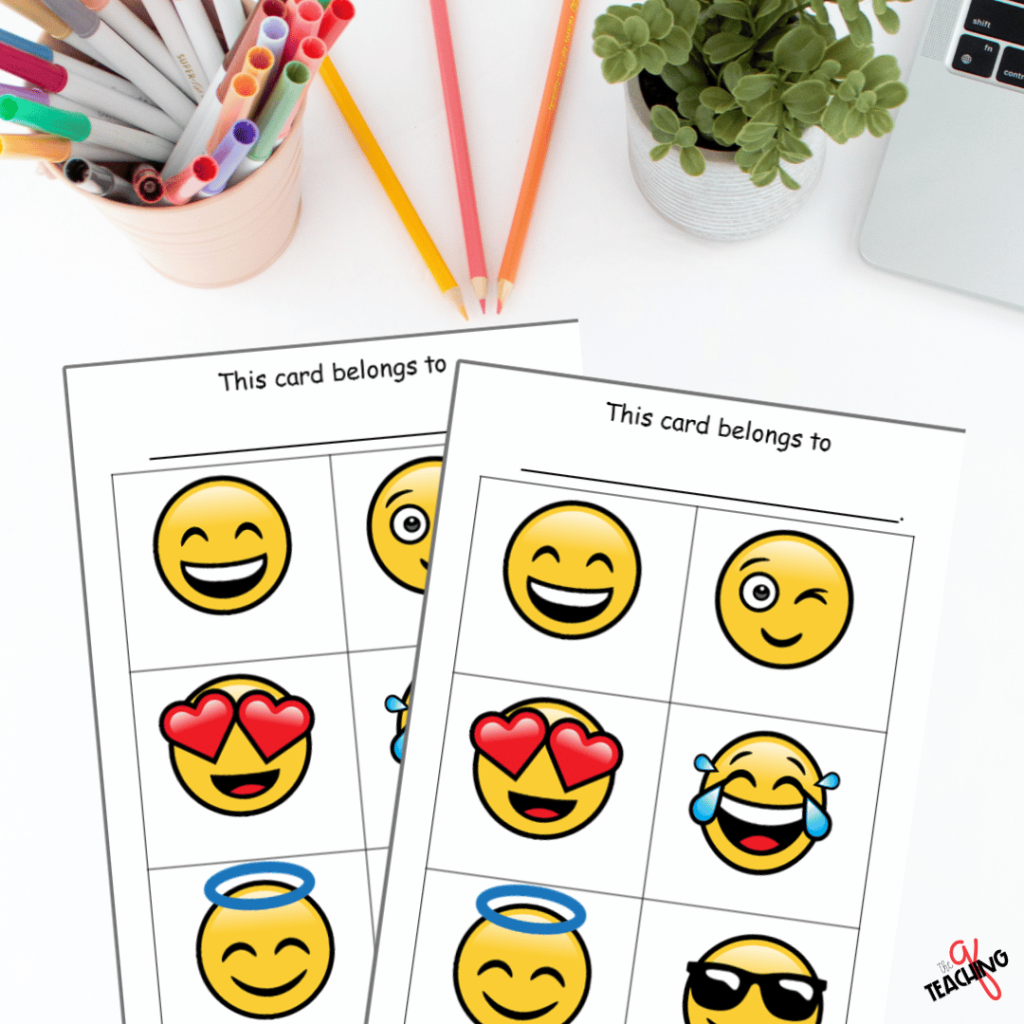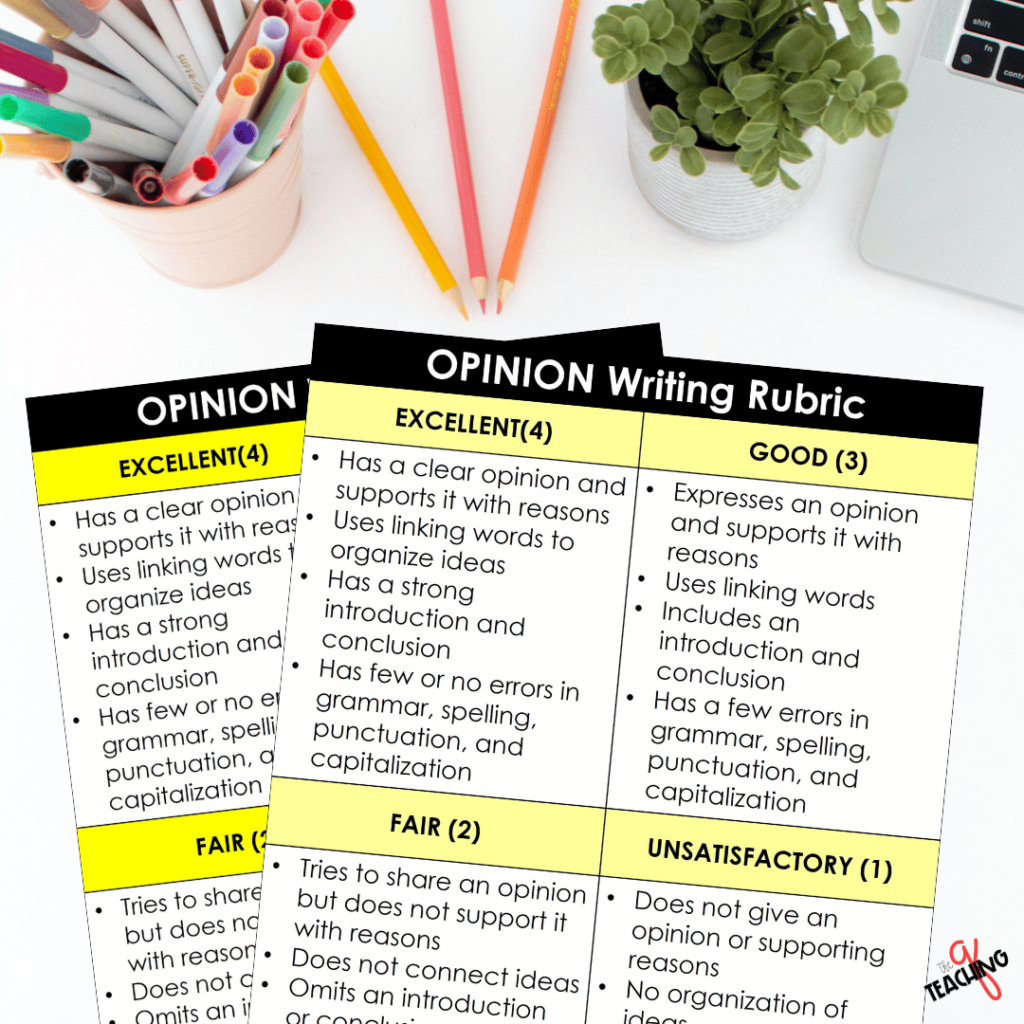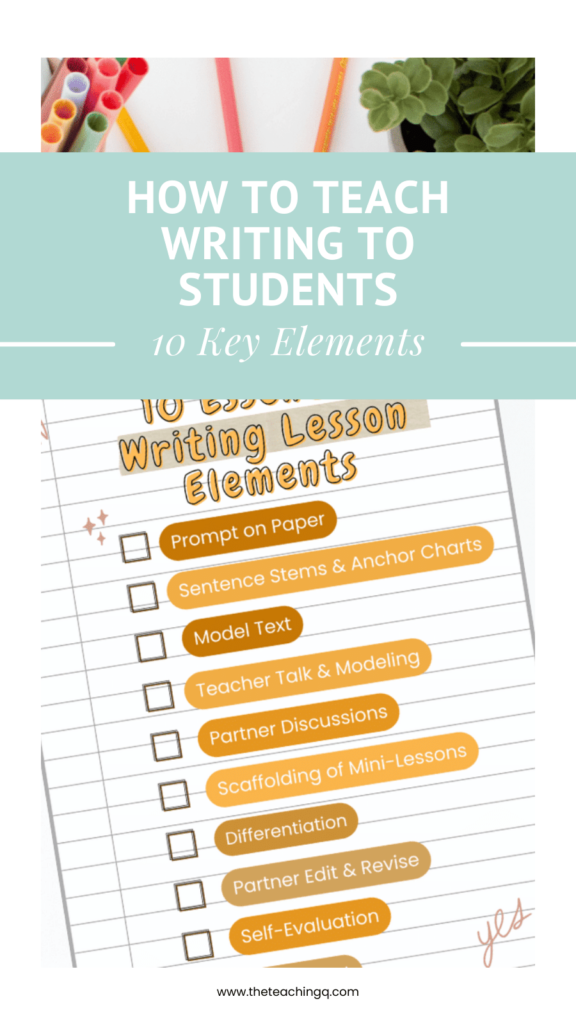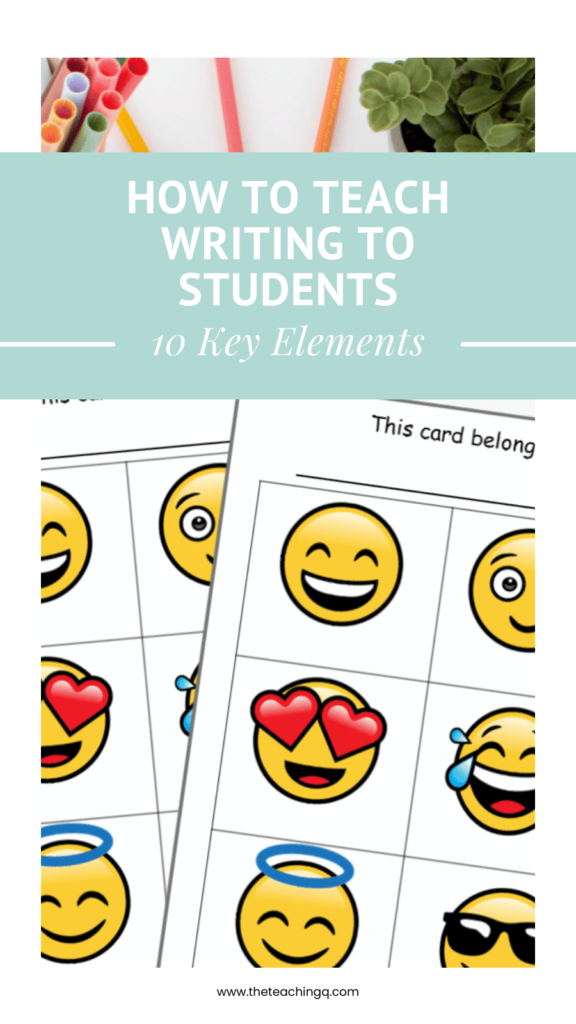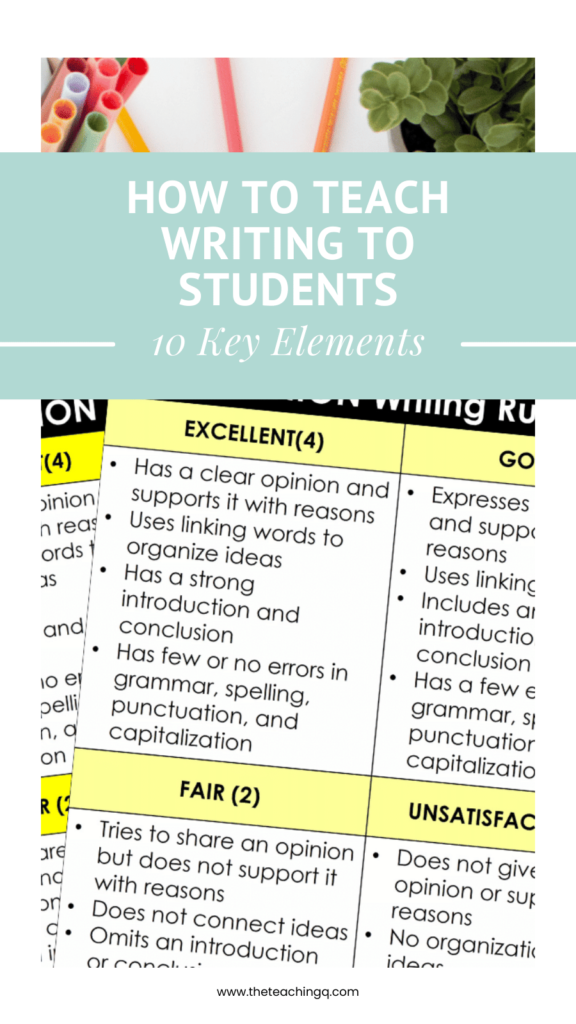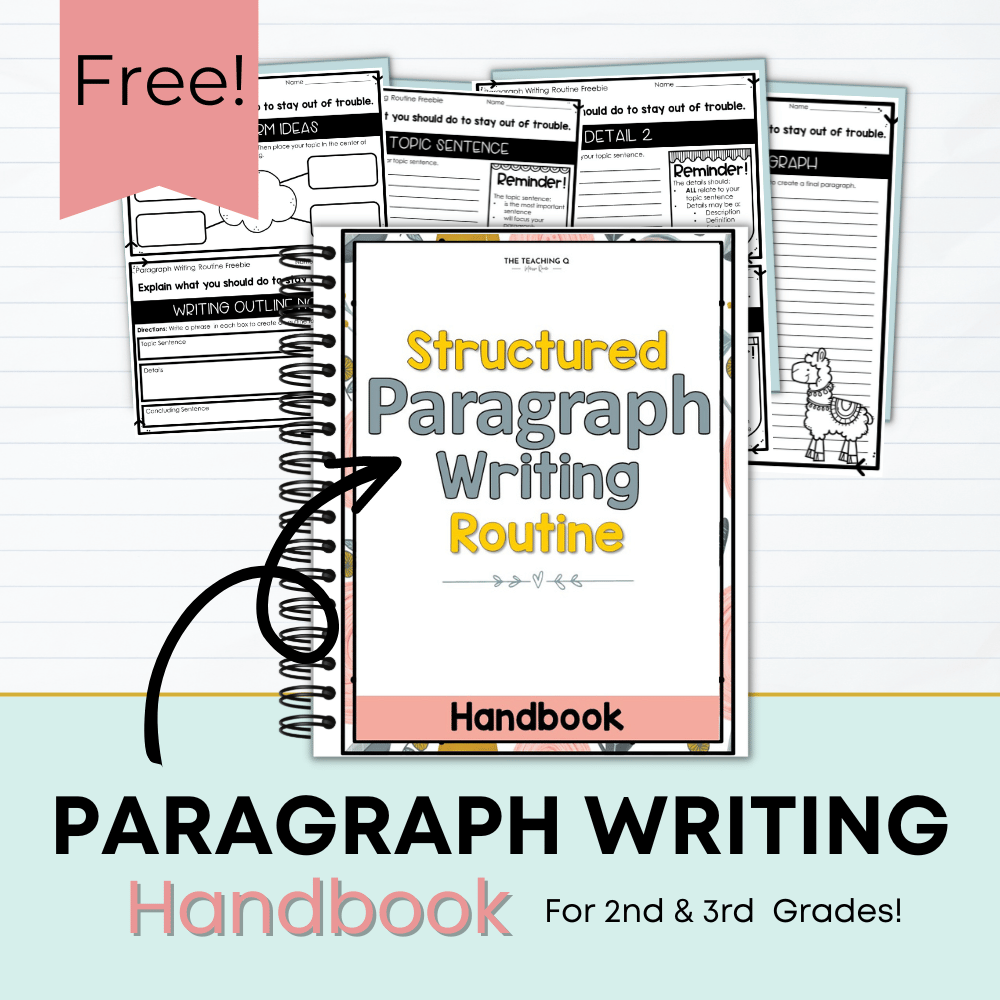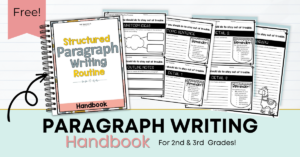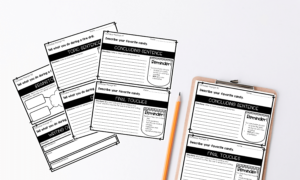How to teaching writing to elementary students can be challenging yet gratifying. To cultivate strong writing skills in students, it’s crucial `to incorporate a well-rounded approach that not only encourages active participation but also nurtures a love for the written word. By integrating these ten essential elements into every writing lesson, educators can foster an environment that inspires creativity, critical thinking, and effective communication.
If you’ve ever started at your lesson plans and wondered how to teach writing to your students, I’ve got ten key elements to include in each writing lesson. But don’t stress. Some are quite simple to incorporate, while a few may take a little more practice before becoming second nature.
Until you have how to teach writing elements down, I’ve created this simple cheat sheet to keep handy during the planning of your writing lessons.
1. Clearly Stated Prompts on the Paper:
Clear, concise writing prompts provide students with a solid foundation to begin their writing journey. These prompts should be thoughtfully crafted to stimulate critical thinking and encourage creativity. By outlining specific guidelines and expectations, students are better equipped to grasp the objectives of the writing task at hand.
Teacher Tip:
When presenting a writing prompt, emphasize the importance of understanding the key components of the prompt before diving into the writing process. Encourage students to highlight or underline essential words or phrases to ensure they remain focused on the topic.
2. Sentence Stems and Anchor Charts for How to Teach Writing:
Sentence stems, and anchor charts offer students a visual representation of the fundamental components of various text structures. By providing a structured framework, students can better comprehend the organization and flow of their writing, enabling them to express their ideas more coherently.
Teacher Tip:
Create interactive anchor charts that students can reference throughout the writing process. Please encourage them to actively participate in creating these charts actively, fostering a sense of ownership and understanding.
The many graphic organizers and writing structures featured in the photo above can be found in my Writing Resource and Notebook here.
3. How to Teach Writing with Model Text:
Incorporating a model text that exemplifies the desired writing style can significantly enhance students’ understanding and implementation of specific writing techniques. By analyzing and deconstructing these model texts, students can gain valuable insights into effective writing strategies and apply them to their own compositions.
Teacher Tip:
Encourage students to actively engage with the model text by identifying key elements such as sentence structure, vocabulary choice, and overall organization. Prompt them to compare and contrast their writing with the model text to identify areas for improvement.
4. How to Teach Writing with Teacher Talk and Modeling:
A crucial element of an effective writing lesson involves live demonstrations and explanations by the teacher. By showcasing real-time examples of the writing process, educators can illustrate various writing strategies and techniques, fostering a deeper understanding among students.
Teacher Tip:
Prior to the writing session, prepare a clear outline of the writing process you intend to demonstrate. Break down each step and explain the rationale behind your choices. Encourage students to ask questions and actively participate in the learning process.
5. Student Partner Talk for Discussions:
Encouraging collaborative discussions among students promotes critical thinking and enhances communication skills. By engaging in meaningful dialogue, students can exchange ideas, provide constructive feedback, and gain diverse perspectives, fostering a supportive learning community.
Teacher Tip:
Implement structured discussion protocols to facilitate productive peer interactions. Encourage students to actively listen to their peers and provide constructive feedback that highlights areas of strength and areas for improvement.
I like to keep my student parents varied using the FREE Student Partner Match-Up Card featured in the image above.
While you are at my store downloading the free resource, will you be so kind as to FOLLOW my TPT store? This way, you’ll be notified of all the new resources. (Thank you!)
6. Scaffolding and Chunking your Mini-Lessons:
Scaffolding or chunking the writing process into manageable mini-lessons can effectively guide students through the intricacies of writing. By gradually introducing complex writing concepts and techniques, educators can scaffold learning to accommodate varying skill levels, ensuring all students can achieve success.
Teacher Tip:
Design a comprehensive curriculum that outlines the progression of writing skills throughout the academic year. Introduce each mini-lesson systematically, allowing students ample time to grasp and apply each concept before moving on to the next.
“Like seeds in a garden, young writers flourish when provided with individualized tools and techniques, allowing their creativity to blossom in its own vibrant hues.”
-Unknown
7. Differentiation of Levels to Support Each Learner:
Recognizing the diverse learning needs of students is paramount in fostering an inclusive learning environment. By implementing differentiated learning strategies, educators can tailor their instructional approach to accommodate individual learning styles, ensuring every student has the opportunity to succeed.
Teacher Tip:
Utilize various instructional strategies, such as differentiated assignments, flexible grouping, and personalized feedback, to cater to the unique learning needs of each student. Regularly assess students’ progress and make necessary adjustments to ensure their continued growth.
8. Partner Editing and Revising Checklist with Discussions:
Promoting peer collaboration during the editing and revising stages of the writing process cultivates a culture of constructive feedback and mutual support. By engaging in collaborative editing sessions, students can refine their writing skills while developing a deeper understanding of the editing process.
Teacher Tip:
Introduce a structured editing and revising checklist that highlights key areas for improvement, such as grammar, punctuation, and content clarity. Encourage students to provide specific and constructive feedback to their peers, focusing on areas that align with the established criteria.
9. Self-Evaluation Procedures with a Rubrics and Checklists:
Encouraging students to assess their own writing fosters a sense of autonomy and accountability. By providing clear evaluation criteria, such as rubrics and checklists, students can self-reflect on their writing progress, identify strengths, and set goals for continuous improvement.
Teacher Tip:
Facilitate self-evaluation sessions by guiding students through the established rubric and checklist criteria. Encourage students to assess their work objectively and set achievable goals for their future writing endeavors.
10. Various Options to Share Student Writing Uniquely:
Providing diverse opportunities for students to share their writing fosters a sense of accomplishment and pride in their work. By incorporating creative platforms for sharing, such as class presentations, digital portfolios, or literary magazines, educators can inspire a genuine appreciation for the art of writing.
I also have this blog post where I discuss twelve ways to have students share their completed writing.
Teacher Tip:
Encourage students to explore various mediums for sharing their writing, such as multimedia presentations, podcasts, or online publishing platforms. Celebrate their accomplishments by organizing a writing showcase or an interactive storytelling event to showcase their unique voices and perspectives.
Don’t forget; you can download and use the Ten Essential Elements for How to Teach Writing here until you have the routine down to pat.
Incorporating these ten elements into how to teach writing not only promotes the development of essential writing skills but also fosters a lifelong appreciation for the power of effective communication. By nurturing a supportive learning environment that encourages collaboration, critical thinking, and self-reflection, we can empower students to become confident and proficient writers equipped with the necessary tools to thrive in the ever-evolving landscape of written expression.
-Melissa
